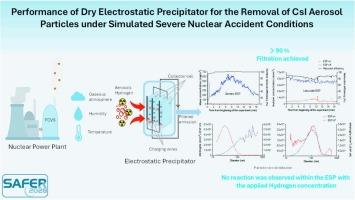干式静电除尘器在模拟严重核事故条件下去除CsI气溶胶颗粒的性能
IF 2.1
3区 工程技术
Q1 NUCLEAR SCIENCE & TECHNOLOGY
引用次数: 0
摘要
为了提高核电站的安全性能,在不同的实验条件下,研究了静电除尘器(esp)减少放射性气溶胶和氢排放的性能。以碘化铯为模型气溶胶,评价了气体气氛、湿度、流速和温度对颗粒特性和过滤效率的影响。结果表明,实验室ESP的最大颗粒质量过滤效率超过90%,工业ESP的最大颗粒质量过滤效率超过99.5%。然而,工业ESP的颗粒数量浓度不同,突出显示了大颗粒的有效去除,这些大颗粒起到了凝结槽的作用,使高浓度的新形成的超细颗粒持续存在于系统中。氢气缓解实验显示,在典型操作条件下,esp对氢气浓度没有可测量的影响,证实了其在现行核电站协议中的安全性。该研究强调了颗粒特性、载气成分和ESP设计在决定过滤效率方面的关键作用,强调需要进一步研究反应器特定条件,以优化ESP性能并增强源项减少策略。本文章由计算机程序翻译,如有差异,请以英文原文为准。

Performance of dry electrostatic precipitator for the removal of CsI aerosol particles under simulated severe nuclear accident conditions
The performance of electrostatic precipitators (ESPs) in reducing the emission of radioactive aerosols and hydrogen was investigated under varying experimental conditions to improve the safety features of nuclear power plants (NPPs). The effects of gaseous atmosphere, humidity, flow rate, and temperature on particle properties and filtration efficiency were evaluated using caesium iodide as a model aerosol. The results indicate that the ESP achieved a maximum particle mass filtration efficiency of over 90 % for the lab-scale ESP and more than 99.5 % for the industrial ESP. However, the particle number concentration varied with the industrial ESP, highlighting effective removal of larger particles that acted as a condensation sink, allowing higher concentrations of newly formed ultrafine particles to persist in the system. Hydrogen mitigation experiments revealed no measurable impact of ESPs on hydrogen concentrations under typical operating conditions, confirming their safety within current NPP protocols. The study highlights the crucial role of particle properties, carrier gas composition, and ESP design in determining filtration efficiency, emphasising the need for further research on reactor-specific conditions to optimise ESP performance and enhance source term reduction strategies.
求助全文
通过发布文献求助,成功后即可免费获取论文全文。
去求助
来源期刊

Nuclear Engineering and Design
工程技术-核科学技术
CiteScore
3.40
自引率
11.80%
发文量
377
审稿时长
5 months
期刊介绍:
Nuclear Engineering and Design covers the wide range of disciplines involved in the engineering, design, safety and construction of nuclear fission reactors. The Editors welcome papers both on applied and innovative aspects and developments in nuclear science and technology.
Fundamentals of Reactor Design include:
• Thermal-Hydraulics and Core Physics
• Safety Analysis, Risk Assessment (PSA)
• Structural and Mechanical Engineering
• Materials Science
• Fuel Behavior and Design
• Structural Plant Design
• Engineering of Reactor Components
• Experiments
Aspects beyond fundamentals of Reactor Design covered:
• Accident Mitigation Measures
• Reactor Control Systems
• Licensing Issues
• Safeguard Engineering
• Economy of Plants
• Reprocessing / Waste Disposal
• Applications of Nuclear Energy
• Maintenance
• Decommissioning
Papers on new reactor ideas and developments (Generation IV reactors) such as inherently safe modular HTRs, High Performance LWRs/HWRs and LMFBs/GFR will be considered; Actinide Burners, Accelerator Driven Systems, Energy Amplifiers and other special designs of power and research reactors and their applications are also encouraged.
 求助内容:
求助内容: 应助结果提醒方式:
应助结果提醒方式:


